Energy Efficient House Design
Thermal Mass and Insulation
by Bruce
Barbour
Version 1.2 - 2009
Aim
The aim of this article is to assist those interested in energy efficient house design to achieve a descriptive theoretical overview and understanding of how a house works thermally. This article primarily investigates the interaction between the effects of insulation (and infiltration), thermal mass and energy / heat supplied (whether from solar or fossil fuel sources). This article does not attempt look at practical design of housing elements or requirements for ventilation for cooling and air quality, which are handled by many text books and Internet sites dedicated to house design.
An Overview
The aim of energy efficient house design is to achieve a house which has a comfortable temperature for the occupants at the time that they are in the house with minimal input of energy from fossil fuel sources or other sources that are either not sustainable or polluting.
Principles of Energy Efficient House Design
Introduction
The temperature in a house is the result of the amount of thermal energy within the external envelop of the house at that time. Changes to the temperature in the house are a result of energy flowing into or out of the house and the amount of energy that is stored in the house. Consequently to understand how a house works thermally it is a matter of understanding the factors that affect the rate of energy flow into and out of the house, and the energy storage of the house. In other words it is necessary to understand the effects of insulation and thermal mass and the addition of energy into the housing envelop, either from solar or other sources.
A Simple Model
To attempt to understand this I will use a very simple model of a house and also make simplifying assumptions about the changing of external temperature. The model to be used is to consider a house to be a box sitting in the environment.
I will discount the effect of the sun shining onto the house and also at present discount any energy input into the house from solar, heaters, equipment or people. (I will discuss the effect of these factors and thermal mass and insulation later.)
At any particular time the air in the house will have a particular temperature (ti) and the air outside the house will have another temperature (to) (usually different to ti). If the internal temperature is higher than the external temperature then thermal energy will flow from the internal to the external, lowering the temperature of the air in the house. If the internal temperature is lower than the external temperature then thermal energy will flow from the external to the internal, raising the temperature of the air in the house.
Over a day the external air temperature will vary from night to day. To assist our theoretical consideration I will idealise this temperature variation to a sinusoidal variation as shown in the figure 1 below. The internal temperature of the house will also vary, as shown below.
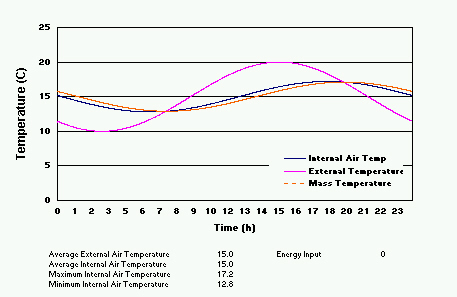 |
There are a couple of things to note about the relationship between the variation of the external and internal temperature (remember the idealisations stated earlier):
- The internal temperature lags behind the external temperature;
- The maximum internal temperature is less than the maximum external temperature, the minimum internal temperature is greater than minimum external temperature; and
- The average internal and external temperature over a 24 hour period is the same.
The question now arises what causes this characteristic relationship between the internal and the external temperature.
The internal temperature lag is effected by two factors:
- The level of insulation of the external envelop; and
- The amount of thermal mass inside the envelop.
Both these factors work together.
What is Thermal Mass
The total Thermal Mass in a building is a measure of the building's ability to store thermal energy. It is related to the mass of the materials in the building and the ability of that mass to store thermal energy. Some materials have a greater capacity to store thermal energy than other materials. For example a kilogram of water can hold more thermal energy per degree Celsius than a kilogram of concrete. Putting it another way it takes more energy to raise a kilogram of water by one degree than to raise a kilogram of concrete by one degree.
It is important to recognise that all materials have a thermal mass of some kind. So, for example, the furniture and other household equipment in a house would contribute to the overall thermal mass of the house. Even the volume of air in a house has thermal mass, although it is quiet small in comparison to other sources of thermal mass in the house.
Obviously the thermal mass of a house is greatly increased if it has solid brick or concrete internal walls compared to a house constructed of lightweight material such as timber stud and plasterboard.
The effect of thermal mass in a house is that the more thermal mass the more stable the internal air temperature will be, that is the maximum and minimum temperature will be closer to the mean temperature with high thermal mass.
(The effectiveness of thermal mass is also effected by how well "connected" with the air in the house. So thermal mass which has a large surface area exposed to the air will stabilise air temperatures better than a mass with a smaller surface area.)
What is Insulation
Insulation has the effect of slowing the flow of thermal energy into and out of a house. The higher the insulation the slower the flow of thermal energy.
All material has some insulating effect. In general terms, dense material has a lower insulation effect. So material such as concrete and glass are not effective insulators, although they do have some effect. A lightweight material such as foam can be a very effective thermal insulator.
Varying Insulation
Back to our Example
Let us assume that the basic box house has a moderate amount of insulation and thermal mass.
If the insulation of the building envelop is increased the effect will be to slow the heat flow into and out off the building. The thermal lag (the time between the maximum external temperature and the maximum internal temperature) will be greater. The internal temperature maximum will be less and the minimum will be more. The range of internal temperatures will be less, staying closer to the average.
 |
Similarly if the insulation is decreased, the thermal energy flow will be greater, thermal lag will be less and the maximum internal temperature will be more and the minimum internal temperature less. The range of internal temperatures will be greater. Note that in both cases the average internal air temperature does not change - it is still the same as the average external air temperature. See figure below:
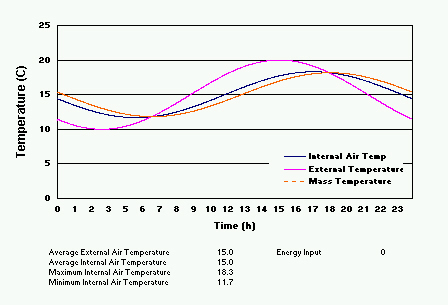 |
If the level of insulation is decreased to approach zero the internal air temperature of the house will closely follow the external air temperature. (Note that it would not be possible to have a closed house with zero insulation as all material has some insulative effect and also the air layer immediately adjacent to the wall material also has an insulative effect.)
Varying Thermal Mass
Now what will happen if the thermal mass is increased internally in the house (Note that in this example I am not talking about placing the thermal in the external walls - this has a different effect to mass that is say in the internal partition walls. I will touch on placing the thermal mass in the external walls later.)
If the thermal mass is increased (while not adjusting the insulation of the building envelop) the rate of flow of thermal energy into and out off the building for any nominated internal / external temperature difference will still be exactly the same as the original building with lower thermal mass. However because now the house has a greater store of energy in the thermal mass the proportion of energy lost compared to the total energy stored in the house is significantly less. Consequently the effect on the internal air temperature will be less. As thermal energy in the internal air leaves the house through the walls the energy in the air is replaced from the energy in the thermal mass. Conversely in summer as thermal energy in the internal air is increased through the walls the energy in the air is will be taken out of the air and stored in the thermal mass.
So what is the overall effect on internal air temperature? The thermal lag (the time between the maximum external temperature and the maximum internal temperature) will be greater. The maximum internal temperature will be less and the minimum will be more.
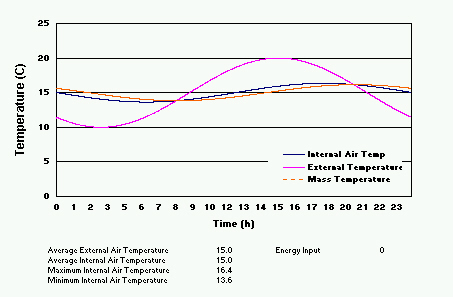 |
Similarly if the thermal mass is decreased the thermal lag will be less and the maximum internal temperature will be less. In all cases the average internal air temperature does not change - it is still the same as the average external air temperature.
 |
As can be seen the effect seems similar to changing the level of insulation. However there are very important differences in the effect of insulation and thermal mass on the thermal performance of a house. One of the differences which I will touch on here is the level of "connectedness" of the mass with the internal air. Practically this means the uninsulated surface area of the mass which is in connection with the internal air (and the how conductive the thermal mass itself is). The larger the surface area (and the more conductive the mass) the quicker the thermal mass can release or absorb its thermal energy. If it has a small surface area it will release and absorb thermal energy more slowly and will therefore be less effective in maintaining an even internal air temperature and the temperature lag could be greater. There are other important differences between thermal mass and insulation which will be dealt with later.
One possible way of thinking about the interaction of the effects of insulation and thermal mass is that insulation increases the effectiveness of thermal mass in maintaining an even air temperature. And conversely thermal mass increases the effectiveness of insulation in maintaining an even air temperature n the house. If you increase insulation you need less thermal mass to get the same temperature variation.
Increasing Air Temperature
As can be seen from the various graphs provided above the inclusion of either insulation or thermal mass or both insulation and thermal mass does not increase the average internal air temperature of the house above the average external air temperature.
If you live in an area where the average external temperature is within your comfortable temperature range solely increasing the thermal mass and insulation will even out the natural temperature uncomfortable lows and highs, bringing the internal temperature of the house into your comfort range at all time. No further heating or cooling would be necessary. However most of us do not live in an area where this is the case all year round.
What thermal mass and insulation do is to even out the temperature so that the difference between the maximum and the minimum is less. This is a good effect - you will experience less extremes of cold and heat than living outside. However the house would still not be very liveable if the average temperature is below (or above) what is comfortable, and it would be even colder (or hotter) than this for half the time.
So how is the temperature in the house increased.
Imagine a situation where some additional energy is input into the house (where the external air temperature is low). The effect of this energy is to raise the internal air temperature above what it would have been with out the energy input. However because the air temperature inside is now greater the difference to the external temperature is also greater so the energy flow to the outside of the house is increased.
So if enough energy is input into the house the average internal air temperature could rise to what would be to a desired level. However to get the average internal temperature to the desired level is certainly not sufficient to guarantee that our house is comfortable. If the energy is put in either evenly over the total twenty four hour period or, preferably, over the period when the air temperature of the house is below the desired level for comfort it will be possible to achieve a comfortable house. This later situation is what typically occurs when external (usually fossil fuel based) heating is used in a house. However as our aim is to limit the use of fossil fuels for heating then there are two possible approaches:
- Decrease the rate of energy flow to the outside by the use of insulation in the walls, roof and floor. With the use of insulation better use is made of the energy input. It takes less energy to increase the average internal air temperature to the comfort zone; and / or
- get the energy from non fossil fuel sources.
Looking at the second point, one source which most housing, with reasonable design input, have access to is solar. However the problem with solar is that, unlike fossil fuels, it is not available when it is wanted or needed, at the flick of a switch. Solar is usually available in the middle of section of the day, usually when external air temperatures are normally higher anyway.
So this is the problem with solar. While heating with solar is desirable it is not always available when most required. If the window openings are simply designed so the amount of solar energy gain is high enough the solar energy may be put into the house over a relatively short period of time in the middle of the day. The air temperature in that period could rise to such a level as to be unbearably hot. In the rest of the time the temperature of the house could still be below the level required for comfort.
In the graph provided below I have supplied sufficient additional energy to bring the average temperature of the house to the desired average temperature of (say) 20 degrees. The energy is applied during the period from 9am to 3 pm to simulate the availability of solar input. I have not adjusted insulation or thermal mass.
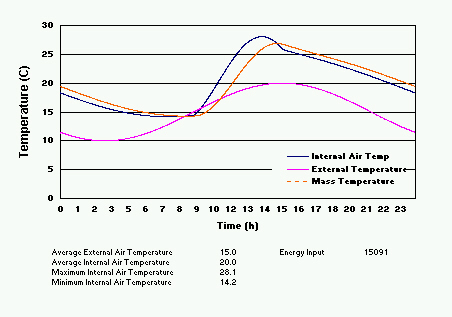 |
The problem which is readily apparent is that during the period from 9am to 3 pm the temperature in the house becomes unbearably hot. At other times the temperature is still less than desired. So even though the average temperature is satisfactory we still haven't got a comfortable house.
What happens if I just double the amount of insulation.
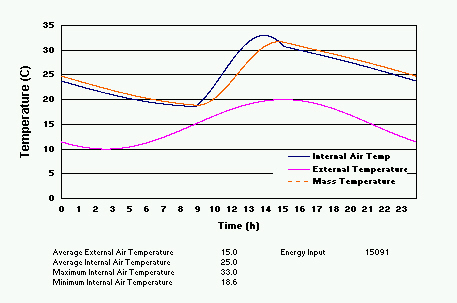 |
This has not solved the problem. While the minimum temperature has increased significantly, the temperature in the middle of the day becomes too hot and the average internal air temperature is also hotter than before.
(If supplying the energy from fossil fuel sources doubling the insulation would mean that the amount of fossil fuel to get back to the temperature distribution shown in figure 4 would halve. It is also important to note that when I say "doubling insulation" it mean doubling insulation for all building envelop elements - wall, windows, roof and floors and also halving air infiltration rates or a combination of this to achieve an effective doubling of the average "R" rating. Simply doubling insulation in the walls would not be sufficient by itself.)
What happens if the amount of thermal mass is doubled (keeping insulation at the original level).
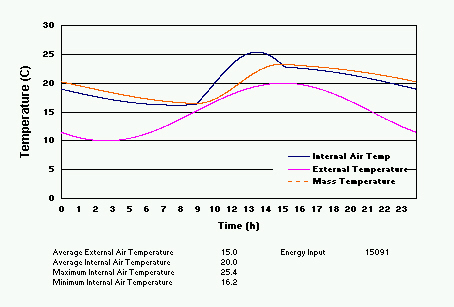 |
This is much more effective. The temperature in the middle section of the day is a lot closer to the comfort level and the temperature outside these times is also closer to the average temperature. The internal air temperature is more stable - the peak temperature is lessened. The solar energy is taken into the house when it is available in the middle of the day and absorbed into the thermal mass - limiting the maximum internal air temperature in this period. The heat is then released later in the day - limiting the minimum internal air temperature.
Heating with Fossil Fuels
For the sake of completeness I will look at heating the house with fossil fuel.
Fossil fuel has the benefit of being available when required.
Continuous Heating
The graph below shows the house heated with a similar amount of energy as the house in Figures 4 to 6. The heat is applied continuously over the fully 24 hours of the day.
 |
As can be seen the average temperature is the same as the houses where the same amount of energy is input into the house by solar. However the internal energy profile is different. The profile is the same as the unheated house only shifted upwards by 5 degrees.
Intermittent Heating
If the house living area is only used, say, in the morning, from 6.30 to 8.30am, and the evening, from 7.00 to 10.00pm, the house would be quite comfortable if the internal air temperature was in the comfort zone in that period.
 |
As can be seen the profile is very different. The total fossil fuel energy used is also significantly less than from the continuously heated house. (Note that while the total energy use for heating the house is less than solar the benefit of solar is its free and non polluting.)
Thermal Mass for Energy Storage
Thermal mass is an energy store. If, say due direct solar input or merely that external temperature has risen above the internal air temperature, the temperature of the internal air raises above the temperature of the thermal mass then the thermal mass will begin take in energy from the air decreasing the rate at which the air temperature will increase. Later, when the solar input is not available and / or the external air temperature drops, when the internal air temperature drops below that of the thermal mass the thermal mass will lose energy to the internal air and consequently the rate at which the internal air temperature drops is less.
The summer advantage of thermal mass is also significant in the appropriate environment. As air temperatures rise the thermal mass can absorb the additional energy in the air and release it later when temperatures drop.
Thermal mass is an energy store that can assist in preventing the air temperature from going outside the desired comfort range, in both summer and winter.
Best Use of Thermal Mass
While I have said that thermal mass will absorb the energy from the air it is better from a design perspective for the thermal mass to absorb the energy from the sun directly. If in the middle of the day when the rays of the sun shine directly onto the thermal mass, the energy will be absorbed directly with out having to first heat the air of the house, which could still raise the air temperature above the comfort zone. (The best approach is to have the sun shining directly onto an internal wall which is high in thermal mass. Other approaches is for the sun to directly heat a high thermal mass floor - typically a slab on ground.)
Problems with Thermal Mass
There are a number of situations where thermal mass could either not be useful at all or even increase energy use. Briefly these are:
- where there is insufficient or zero direct solar contribution - the house does not get any or sufficient sun directly into it due to orientation or over shadowing or location (eg. alpine). Fossil fuel use could actually increase in winter as it is necessary to heat the thermal mass as well as the internal air. The energy in the thermal mass could then be released later at a time when it is not being most useful in keeping the occupants warm. (In situations like this it may be best to just increase insulation levels and cut down infiltration losses.)
- Tropical environments where the average air temperature is above the normal comfort zone most of the time. Thermal mass may have the effect of keeping the air temperature above the comfort zone. (It may be possible to use high thermal mass in tropical or subtropical areas provided the overnight temperature got to a low enough level to provide useful coolness. You would have to consider systems (possibly active systems) for night time purging of heat from the building to bring the temperature of the building and the thermal mass to below the day time targeted in door temperature. If over night temperatures do not drop sufficiently below the targeted day time temperature cooling would not be possible - except perhaps through a system of radiative cooling which is still experimental and beyond the scope of this article.)
Thermal Mass on External Surfaces
Thermal mass on external wall surfaces has a different effect on house temperature than mass that is entirely within the walls of the house. This is because energy heat from the thermal mass can flow directly to the outside of the house instead of having to heat the internal air first. This makes it slightly less effective than mass that is entirely internal and also increases the thermal lag characteristic of the house.
Conclusion
In any design of a comfortable solar house the designer needs to keep in mind the principles of heat flow, storage and heat input (whether from solar or fossil fuel sources), and the relationship between these aspects.
